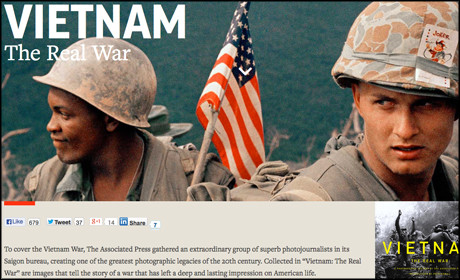
Journalists and photographers from the Associated Press have captured some momentous occasions in history, and earlier this year the newswire decided to launch a new online platform to showcase just some of that content, and the surrounding stories.
It began with the 50th anniversary of the day 'the burning monk' Thich Quang Duc, set fire to himself in protest in June 1963. As the anniversary approached, the creative team along with the corporate archives team considered ways they could make use of the "ton of terrific content" they had access to from years gone by, to re-tell the story as it happened.
In particular, they wanted to focus on a particular image by AP journalist Malcolm Browne, and used the opportunity to showcase that image as well as others, and share the wider story around them, including how he was advised in advance that "something very important will happen".
"In our physical building, on the 15th floor, we do an exhibit," Mike Bowser, director of branding and creative services for AP, explained. "We have all kinds of mounted pictures, and items that go along to tell the story of Malcolm Browne and we started to think wouldn't it be great if we could somehow open that up to allow more people to explore and get a sense for how AP was a part of telling that story."The idea came out of looking for ways to make our archive more accessible and digital seemed to be the natural way to do thatMike Bowser, AP
"So the idea came out of looking for ways to make our archive more accessible and digital seemed to be the natural way to do that because we could share it out through social media, and have a lot more people be able to interact and engage with the content."

The first AP Explore project, which was published in June this year
He stressed that the projects are "very different than an editorial interactive". Instead they are produced with the goal "to support strategic marketing efforts", but they do also highlight ways to share in-depth stories, particularly those which cover an expanse of time, in an immersive way online.
The next Explore project, for example, was focused on the Vietnam war, and was centred around a timeline, built using open-source tool Timeline.js.

The second AP Explore project was built around a timeline tool
"What we want to do is provide a meaningful experience so that viewers can interact with the content, and then also understand that there's the opportunity for them to go off and go to images or archive and licence that video and the images."
Again, images play a significant part in the Vietnam Explore page, including a famous photo captured by AP photographer Nick Ut, showing children running from a napalm bombing. We spoke to Ut on the 40th anniversary of the event last year, when he explained what happened at that moment, and immediately after.
The most recent Explore project was created for the 50th anniversary of President John F Kennedy's assassination on Friday (22 November). This featured images from the AP archive, as well as a written timeline of events, audio, an annotated Google map, key quotes and links to video.

The latest version was published earlier this month
"What keeps them consistent and the theme throughout them all is looking at the role that AP has played in telling that specific story," Bowser told Journalism.co.uk.
"So, it was an AP journalist that captured the burning monk photo, AP had one of the best teams to tell the story of the Vietnam war, AP played a really critical role in capturing the very first photographs in the moments of the JFK assassination, so it does tend to be through the lens of AP's position, but it might not necessarily be event-specific."What keeps them consistent and the theme throughout them all is looking at the role that AP has played in telling that specific storyMike Bowser, AP
Overall, the aim of the project is two-fold. To flag up the key content available in the AP archives to clients, as well as it being "an opportunity for us to speak to the general public".
Planning for the projects starts around two months ahead of the event, or planned publication date, and organised collaboration is key, he explained.
"We co-ordinate with a lot of our other teams, so with our social media team, marketing, to make sure that everybody knows that they're happening and try to craft a message that speaks to what that experience is."
When it comes to the technical production, the projects are "pretty lightweight", he added.
"It's not a lot of development. We use open source tools, so they're built using html5 and CSS 3 open source responsive frameworks. And then we go in and adjust the layout, to work with the story." Bowser also referred to the significant input of designer Thomas Browne.
And the impact of the end products so far "has been encouraging", he said. Readers have been found to spend between 3.5 and 4 minutes viewing the immersive features, he said, "which is pretty high".
The first project has recorded the highest social media shares so far, with 740 likes on Facebook, 220 tweets and 48 shares on Google+.
Free daily newsletter
If you like our news and feature articles, you can sign up to receive our free daily (Mon-Fri) email newsletter (mobile friendly).











